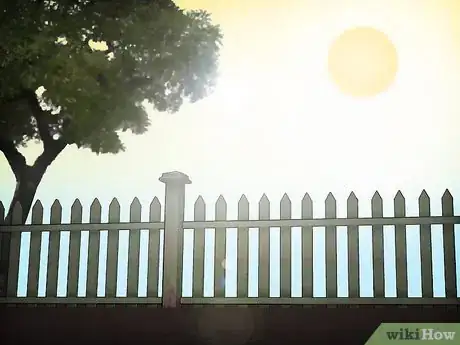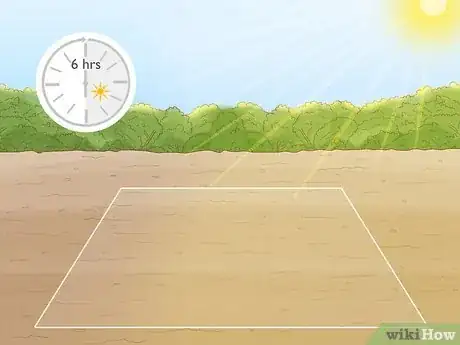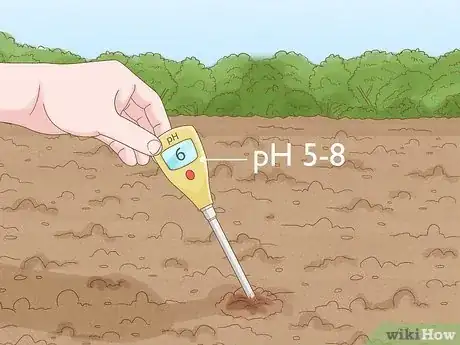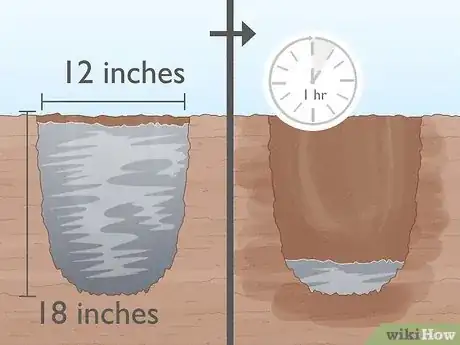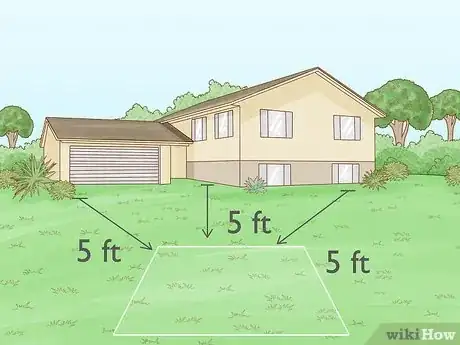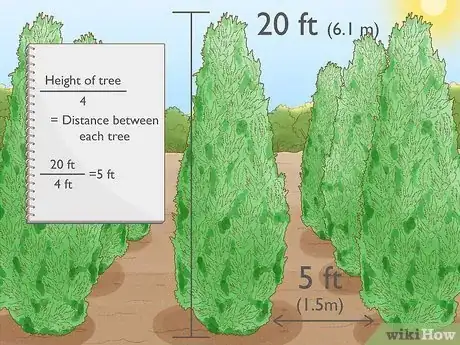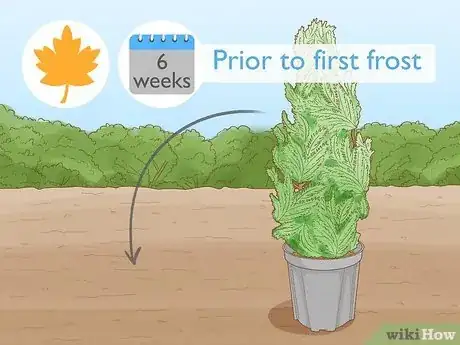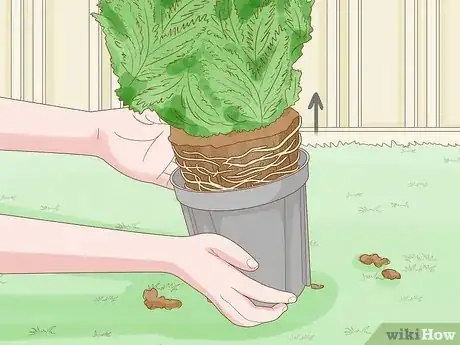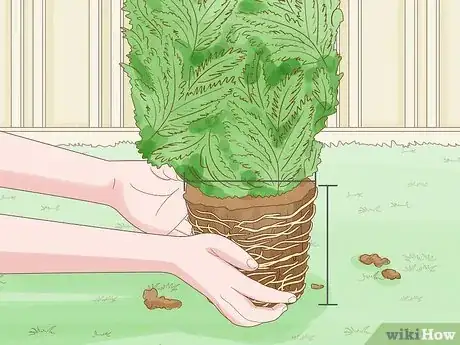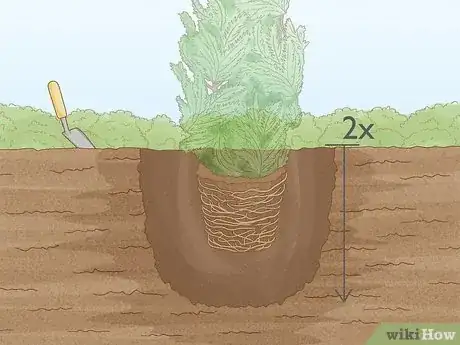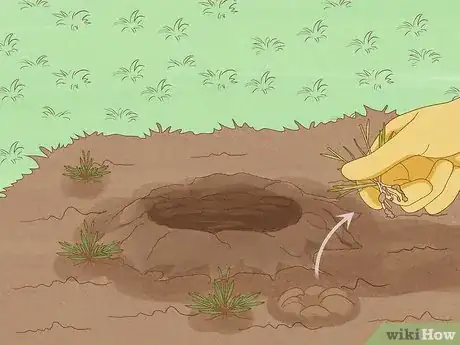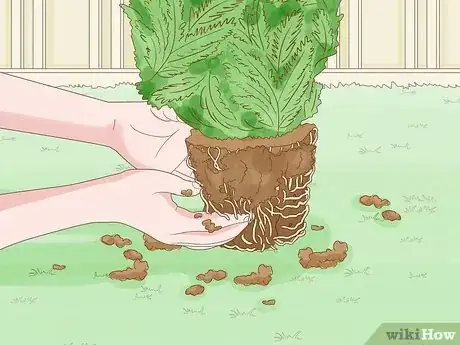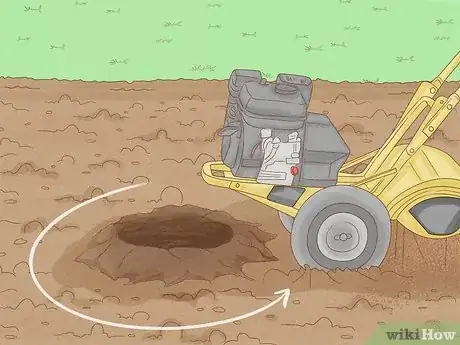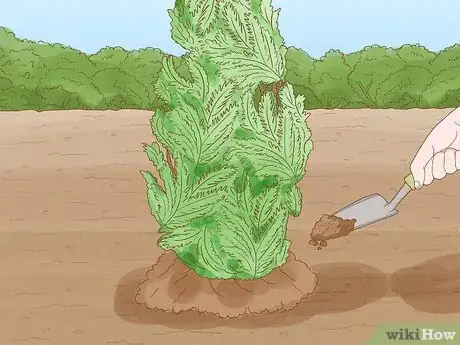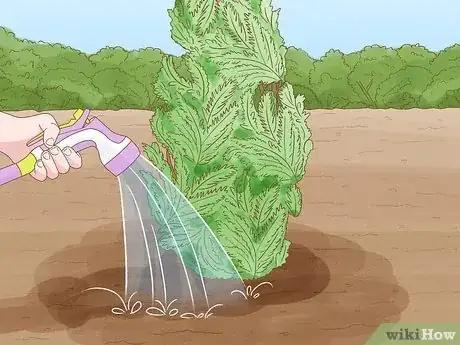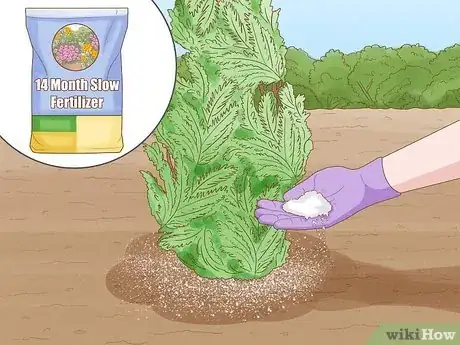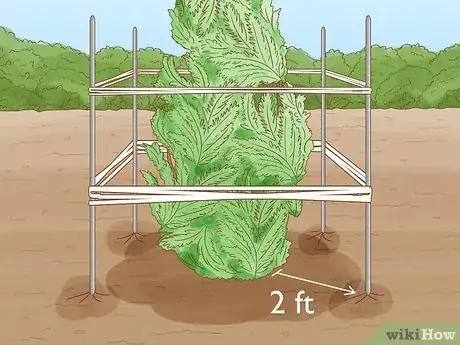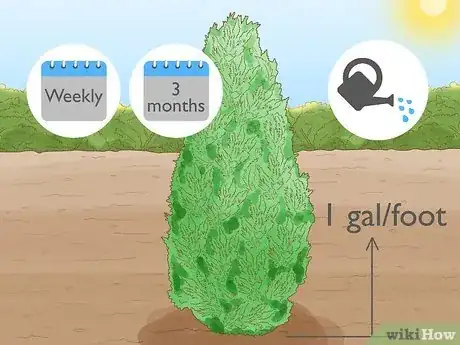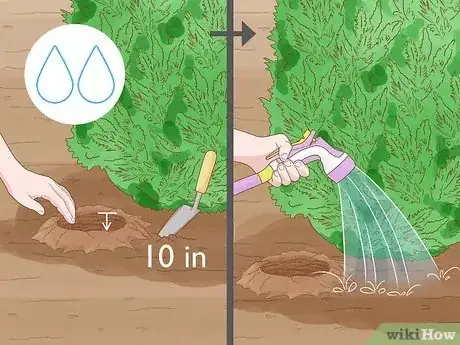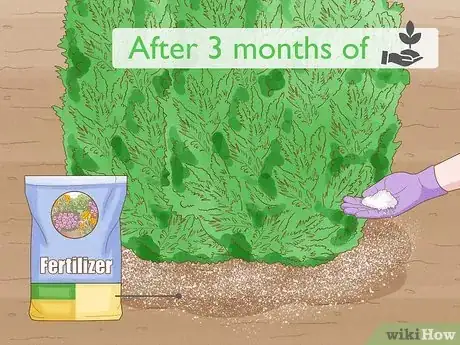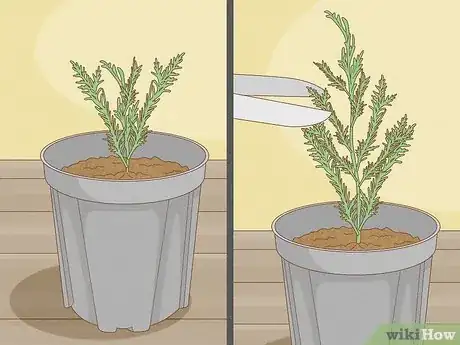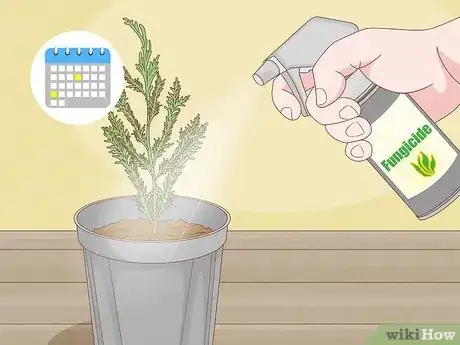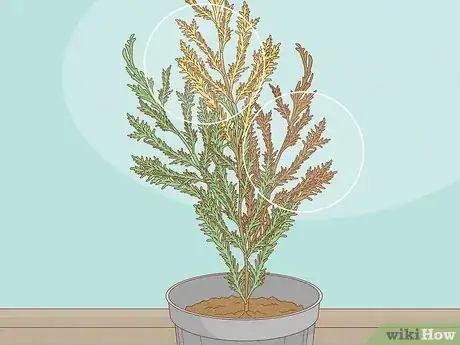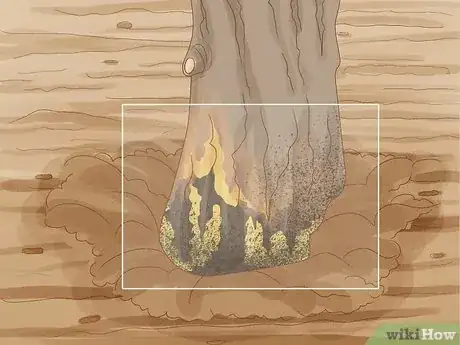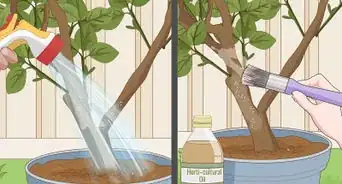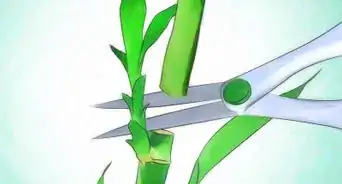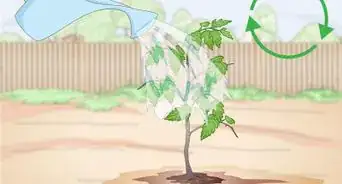This article was co-authored by Maggie Moran. Maggie Moran is a Professional Gardener in Pennsylvania.
There are 11 references cited in this article, which can be found at the bottom of the page.
wikiHow marks an article as reader-approved once it receives enough positive feedback. In this case, 100% of readers who voted found the article helpful, earning it our reader-approved status.
This article has been viewed 189,468 times.
The Leyland Cypress tree is a hybrid of the Alaska-cedar and Monterey Cypress. It has recently become a very popular choice for Christmas trees because it grows faster and requires much less maintenance than the Virginia pine. You can plant your own Leyland Cypress to beautify your property, to sell, or to save money on future Christmas tree purchases. You can do this by carefully choosing your location, planting your tree, and caring for your tree.
Steps
Choosing Your Location
-
1Find an area that provides 6 or more hours of direct sunlight daily. Anything less is not considered full sunlight. Keep in mind that the 6 hours of sunlight does not have to be continuous. Partial sunlight is 4 to 6 hours and — although it probably won't kill the tree — is not ideal.
- Shade can decrease your tree's vigor, which can lead to thinning and heightened disease susceptibility.[1]
- Full sunlight isn't as important in the tree's later years, as mature trees will usually grow tall enough to avoid being shaded by other plants and trees.
-
2Plant your trees in the proper plant hardiness zones. Leyland Cypress trees can thrive in USDA plant hardiness zones 6 to 10, which comprises of temperatures between −5 to 35 °F (−21 to 2 °C).[2]
- A map of USDA plant hardiness zones can be viewed here: http://planthardiness.ars.usda.gov/PHZMWeb/.
Advertisement -
3Check soil pH using your pH tester. Leyland Cypress can grow in various soil types, although optimal pH is between 5.0 to 8.0. If your pH is outside of this range, you can add limestone, sulfur, or aluminum sulfate to adjust it.
- For low-magnesium soils, use dolomitic limestone to raise pH. If your soil is high in magnesium, use calcitic limestone to raise its pH. [3]
- Regular sulfur additions can gradually decrease pH over time, although its effectiveness depends on temperature, moisture, and bacterial presence.
- Aluminum sulfate additions can decrease pH instantly. However, this immediate action can make it difficult to control the extent of the pH reduction.[4]
-
4Dig a hole and fill it with water to test soil drainage. Leyland Cypress should be planted in a well-drained location.[5] To test soil drainage, dig a hole 12 to 18 inches (30 to 46 cm) across and deep. Fill it with water and see how long it takes to drain. Anything 1 hour or more indicates poor soil drainage.
- The addition of organic matter such as manure, peat moss, or compost, can improve soil drainage.
-
5Choose a location that places trees at least 5 feet (1.5 m) apart. Leyland Cypress trees can grow to be fairly wide at the base. Always make sure to give your trees plenty of space from your home, as well as other trees and shrubs.
-
6Divide your desired height by 4 if you're creating a staggered row. Many people use Leyland Cypress trees to create screens or hedges. In this case, decide on the height of the screen and divide it by 4. For example, a row of trees 20 feet (6.1 m) high, keep each tree approximately 5 feet (1.5 m) apart.[6]
- If your trees are too close, weaker trees will become smothered by the larger ones.
Planting Your Tree
-
1Plant Leyland Cypress trees when they are dormant. The best time to plant Leyland Cypress trees is in fall when they are dormant. Around 6 weeks prior to the first frost, usually mid-fall, is the best time to plant. Although this is not essential, it will increase the tree's chances of survival.[7]
- Planting trees outside of the dormancy period can place them under unnecessary stress. Particularly in the spring, when providing them with the amount of water necessary for growth is difficult.
-
2Remove the Leyland Cypress plant from its original container. Tap the container on the outside the loosen the edges of the soil. Carefully slide your tree from the container, taking care to keep the soil around the roots intact and prevent the separation of roots from the tree.[8]
- If your tree becomes root-bound, use a knife to cut an "X" along the root ball's bottom. Follow this by making four cuts vertically along the root ball's sides.
-
3Assess the plant's root bundle to determine the size of its hole. Use a measuring tape to get a rough idea of how big the root ball is in terms of length and height. Afterwards, return the plant to the container or set it aside until you're ready to plant.
-
4Dig a hole approximately twice the size of the plant's root bundle. Use a shovel to dig a hole that's about twice the size of the root bundle to accommodate the plant's growing root system.
- Use a garden fork to loosen the sides of the hole, but not so much that the sides begin to collapse.[9]
-
5Pull up any grass and weeds in and around the hole. Put on gardening gloves and remove any weeds that you see. You can use a trowel or knife to loosen the soil around the weeds and cut into their roots to prevent them from growing back.[10]
- Place your grass and weeds into a bucket to prevent them from spreading seeds.
- Sprinkling salt onto the bottom of weed plants can help kill them over time.
-
6Use your hands to loosen the soil around the roots. Gently brush off soil around the root balls. Avoid damaging the roots, as this will cause the plant stress during transplanting.
- You're always going to damage some roots even if you're careful. Just try to minimize damage as much as possible.
-
7Loosen the soil in the region around your planting location with a tiller. Use a tiller to loosen the soil in a 6 feet (72 in) diameter around the hole location. This will ensure that your plant's roots have enough space to spread out.
- Adding organic matter like peat moss, compost, or leaf mold can help loosen the soil.
- Improper root growth is one of the main causes of Leyland Cypress death.[11]
-
8Place the plant into the hole. When placing your tree into the hole, make sure that the top of the root bundle will be approximately 0.25 inches (0.64 cm) below the ground surface.
-
9Pack topsoil around the roots firmly. Firmly pack scoops of topsoil around the roots until they are covered and the plant's crown is right above the soil line.
- Good quality topsoil will provide the right combination of nutrients for healthy plant growth and proper water retention.
-
10Water the tree until the soil is moist to the touch. Always water immediately after planting while the soil is loose. Press the soil down gently after watering to circulate the water through the soil.
-
11Apply starter fertilizer at the time of planting. Giving your freshly planted tree fertilizer is a great boost. Afterwards, don't fertilize it until 3 months following planting. Fertilizing earlier will promote the growth of the top at the expense of root system growth.[12]
-
12Stake the tree to secure it from bending in the wind. Place 3 to 4 metal or wooden stakes around the base of the tree approximately 2 feet (24 in) away and tie each of them to the tree using string.
- Securing your tree to stakes keeps it from bending in the wind.
Caring for Your Tree
-
1Water your tree with 1 gallon (3.8 L) per foot of height weekly. Plan for approximately 1 gallon (3.8 L) of water per foot of height each week. Use your best judgment—if the soil is becoming soggy, decrease the amount of water you use.[15]
- Leyland Cypress' need adequate water—even during the fall, their evergreen foliage typically lose water.
- Water regularly for the 2 to 3 months following planting. After this period, the tree will have a well-developed root system and won't need as much watering.
-
2Monitor soil moisture by creating a small gap. Use your shovel to create a gap 4 inches (10 cm) deep near the base of your tree. To determine moisture, feel the soil in the gap—if it's dry, water your tree.[16]
-
3Fertilize your tree well in approximately 3 months. Once the root system has been established, you can fertilize your tree again. This will speed the growth of your tree and help it to flourish.
-
4Prune your Leyland Cypress using garden pruners. Begin pruning your tree when it reaches 3 to 4 inches (7.6 to 10.2 cm) in height. Only prune the sides, and take care not to remove more than 3 to 4 inches (7.6 to 10.2 cm) of growth.[17]
- If you want your tree to stop increasing in height, cut its central upright stem as well as its outside branches.
-
5Apply fungicide every 7 to 10 days after pruning. Regular fungicide application for at least 6 weeks after shearing will minimize the chances of fungal infection. This is important because shearing temporarily reduces food production, which weakens the tree.[18]
-
6Watch out for yellow or brown foliage, which are signs of canker diseases. The most common are Seiridium canker and Botryosphaeria canker, both of which create yellow or brown foliage. Avoid excessive watering and cut any twigs that show signs of cankering.[19]
-
7Keep an eye out for dark and decayed roots, which are signs of root rot diseases. Although not common, root rot diseases are dangerous. Once a tree is infected, there is no way to cure it. Any infected trees, including their stumps, should be removed completely.
-
8Remove female bagworms during early spring and winter. Keep an eye out for female bagworms, which carry egg-containing bags that can reach up to 2 inches (5.1 cm) when complete. Adult females do not have legs or wings, are yellow in color, and have an appearance akin to a maggot.
- Bags should either be destroyed or placed into a 5 gallons (19 L) container. This allows any helpful parasites to escape the bags while keeping bagworm larvae contained.
- Pests can also be treated with a mild insecticidal soap or spray.
Expert Q&A
Did you know you can get expert answers for this article?
Unlock expert answers by supporting wikiHow
-
QuestionWhat is the best time to plant Leyland cypress trees?
 Maggie MoranMaggie Moran is a Professional Gardener in Pennsylvania.
Maggie MoranMaggie Moran is a Professional Gardener in Pennsylvania.
Home & Garden Specialist
-
QuestionHow far apart do you plant Leyland cypress?
 Maggie MoranMaggie Moran is a Professional Gardener in Pennsylvania.
Maggie MoranMaggie Moran is a Professional Gardener in Pennsylvania.
Home & Garden Specialist
-
QuestionHow do you plant a cypress tree?
 Maggie MoranMaggie Moran is a Professional Gardener in Pennsylvania.
Maggie MoranMaggie Moran is a Professional Gardener in Pennsylvania.
Home & Garden Specialist
Things You'll Need
Choosing Your Location
- pH tester
- Limestone
- Organic materials
- Measuring tape
Planting Your Tree
- Post-hole digger or shovel
- Top-soil
- Tiller
- Gardening gloves
- Trowel or knife
- Gardening fork
- Fertilizer
- Measuring tape
- Metal or wooden stakes (optional)
- String (optional)
Caring for Your Tree
- Watering bucket
- Fertilizer
- Garden pruners
References
- ↑ http://www.caes.uga.edu/newswire/story.html?storyid=4006&story=They%27re-inexpensive-and-they-grow-quickly.
- ↑ https://www.thetreecenter.com/planting-leyland-cypress-trees/
- ↑ http://extension.msstate.edu/content/soil-testing
- ↑ http://www.clemson.edu/extension/hgic/plants/other/soils/hgic1650.html
- ↑ https://athenaeum.libs.uga.edu/bitstream/handle/10724/34451/LeylandCypress.pdf?sequence=1&isAllowed=y
- ↑ https://www.thetreecenter.com/planting-leyland-cypress-trees/
- ↑ https://www.thetreecenter.com/planting-leyland-cypress-trees/
- ↑ https://www.arborday.org/trees/planting/containerized.cfm
- ↑ https://www.thetreecenter.com/planting-leyland-cypress-trees/
- ↑ http://www.teleflora.com/blog/gardener-tips-5-ways-to-make-removing-weeds-easier/
- ↑ http://www.walterreeves.com/how-to-archive/leyland-cypress-planting-correctly/
- ↑ http://www.walterreeves.com/how-to-archive/leyland-cypress-planting-correctly/
- ↑ http://www.auckersnursery.com/growing.htm
- ↑ http://www.pcmg-texas.org/trees/125-when-do-i-fertilize-newly-planted-leyland-cypress
- ↑ http://www.walterreeves.com/how-to-archive/leyland-cypress-planting-correctly/
- ↑ http://www.caes.uga.edu/newswire/story.html?storyid=4006&story=They%27re-inexpensive-and-they-grow-quickly.
- ↑ http://www.auckersnursery.com/growing.htm
- ↑ http://www.auckersnursery.com/growing.htm
- ↑ http://extension.uga.edu/publications/detail.html?number=B1229&title=Diseases%20of%20Leyland%20Cypress%20in%20the%20Landscape
About This Article
To plant Leyland cypress, wait until about 6 weeks before the first frost of the season and then choose an outdoor area with well-draining soil and at least 6 hours of direct sunlight per day. Then, remove the plant from its original container and dig a hole that's twice the size as its root bundle. Next, loosen the soil around the roots and place the plant into the hole so the top of the root bundle is about 1/4 inch below the ground surface. Finally, fill in the hole, pack the soil firmly around the roots, and water your plant thoroughly. To learn how to fertilize and stake your Leyland cypress, scroll down!
